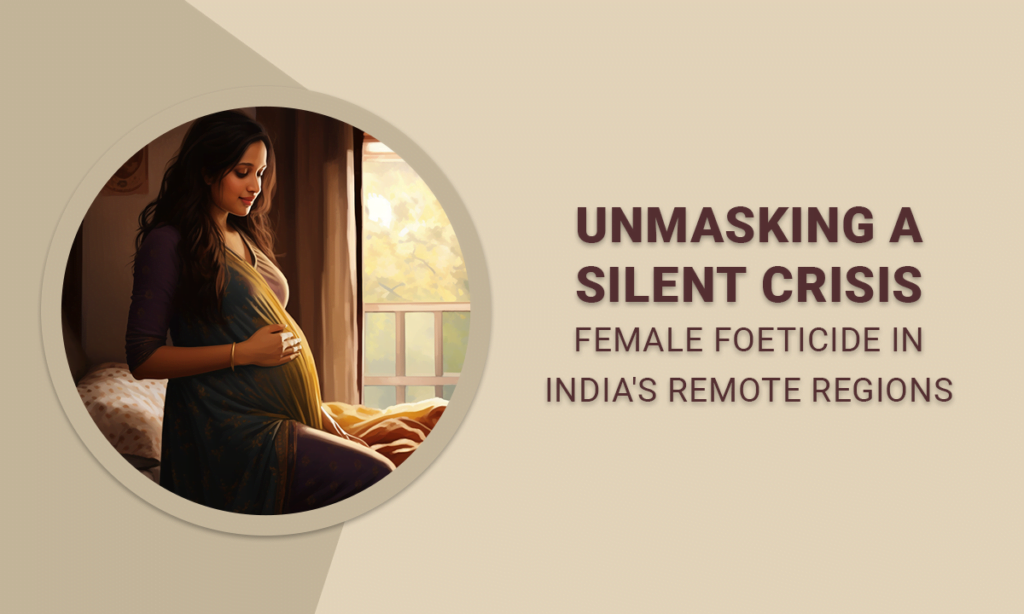In the vast tapestry of India’s rich cultural landscape, a silent crisis looms that has far-reaching implications for gender equality and societal balance – female foeticide. Despite the nation’s progress in various sectors, the deep-rooted issue of female foeticide persists, particularly in its remote regions. This practice not only disrupts the gender balance but also reflects broader social issues that need urgent attention and systematic change.
The Shadowed Practice
Female foeticide, the act of selectively aborting female fetuses, has its origins in cultural, social, and economic factors. The patriarchal mindset, combined with the dowry system, often leads to families preferring male offspring. This preference is driven by the belief that sons will carry the family name and be a source of economic support in old age, whereas daughters are considered an economic burden due to the dowry system.
The Role of Technology
The introduction of ultrasound technology has worsened the problem. While initially intended for medical diagnostics, ultrasound scans have been misused for gender determination, leading to sex-selective abortions. This has created a deadly synergy between age-old biases and modern technology, enabling the continuation of this harmful practice.
Consequences Beyond Gender Imbalance
The consequences of female foeticide extend far beyond the skewed gender ratio. Imbalanced sex ratios result in a shortage of brides, leading to an increase in human trafficking, forced marriages, and other forms of exploitation. Additionally, the absence of women within communities can hinder social and psychological development, as women play crucial roles in nurturing families and fostering healthy societies.
Rooted in Socio-Economic Factors
It’s important to recognize that female foeticide is rooted in socio-economic factors. Addressing the crisis requires tackling deeply ingrained beliefs and customs while simultaneously addressing the economic concerns that drive these practices. This calls for multi-faceted solutions that involve education, economic empowerment of women, and legislative reforms.

Empowerment Through Education
Education acts as a catalyst for change. By promoting education for both boys and girls, societies can challenge traditional norms and raise awareness about the importance of gender equality. Schools should teach about the value of women in society, instilling a sense of respect and equality from a young age.
Economic Empowerment
Empowering women economically can alter the perception of daughters as burdens. Skill development programs and entrepreneurship opportunities can enable women to contribute financially to their families, breaking the cycle of dependency on male offspring.
Legal Reforms and Enforcement
Stringent enforcement of laws prohibiting gender determination tests and sex-selective abortions is crucial. Moreover, policies that provide incentives for families raising daughters, such as education grants and financial support, can motivate a shift in attitude.
Community and Media Participation
Community involvement, coupled with media campaigns, can help dispel myths and stereotypes surrounding gender roles. Highlighting success stories of women breaking barriers can inspire change and promote a more inclusive society.
The Importance of Changing Mindsets
At the heart of the female foeticide crisis lies the need to shift mindsets and challenge deep-seated biases. Traditional notions of gender roles and societal expectations contribute to the perpetuation of this harmful practice. It’s essential to engage in open dialogues within communities to debunk myths surrounding the roles and capabilities of women. Encouraging men to become allies in the fight against gender-based discrimination can be a pivotal step in breaking down these barriers.
Healthcare Reforms and Ethical Practices
The medical community also plays a critical role in addressing female foeticide. Healthcare professionals must adhere to ethical guidelines that prohibit revealing the gender of a fetus unless medically necessary. Additionally, fostering a culture of empathy and understanding within the medical field can discourage doctors from participating in sex-selective practices.
Media’s Responsibility in Shaping Perceptions
The media holds immense power in shaping perceptions and opinions. By using its influence to promote gender equality and challenge stereotypes, media outlets can actively contribute to the transformation of societal norms. Media campaigns, documentaries, and news stories that shed light on the consequences of female foeticide can have a profound impact on raising awareness and galvanizing public support.

The Role of Men in Eradicating Female Foeticide
Men have a pivotal role to play in ending female foeticide. By being vocal advocates for gender equality, fathers, brothers, and husbands can influence family decisions and set an example for their peers. Men’s active involvement in discussions about the value of daughters can help break the cycle of discrimination and foster a more balanced society.
Government and NGO Collaboration
Government bodies and non-governmental organizations (NGOs) must collaborate closely to address the issue at its roots. This includes implementing comprehensive awareness campaigns, providing accessible and affordable healthcare, and ensuring the enforcement of laws against sex determination and selective abortions. Moreover, NGOs can create safe spaces for women to learn about their rights, gain skills, and access resources that empower them.
Measuring Progress and Staying Committed
Eradicating female foeticide is a complex and long-term endeavor. Measuring progress requires tracking gender ratios, monitoring healthcare practices, and evaluating changes in societal attitudes. Staying committed to this cause demands consistent effort, as even small shifts in perceptions and practices can have a cascading effect on the entire society.
The Global Perspective and Collaborative Solutions
While female foeticide is a pressing issue in India, it’s crucial to recognize that it’s not limited to its borders. Gender-based discrimination, including sex-selective practices, is a global concern that transcends cultures and societies. By collaborating with international organizations, sharing best practices, and learning from the experiences of other countries, India can strengthen its efforts to combat this crisis.
Educating the Next Generation
The younger generation holds the key to sustainable change. Integrating gender equality education into school curricula can shape young minds to challenge stereotypes and promote respectful relationships. By teaching children to embrace diversity and respect all genders, we can create a more inclusive society that values each individual’s potential.
Supporting Survivors and Amplifying Voices
Survivors of female foeticide, as well as women who have broken barriers to achieve their dreams, have powerful stories to share. Providing platforms for these individuals to tell their stories can inspire others and provide hope in the face of adversity. Their triumphs can serve as beacons of change, motivating society to rethink harmful practices and celebrate women’s achievements.
A Vision of a Balanced Future
Imagine an India where every daughter is welcomed with the same joy as a son, where women are viewed as equal partners in progress, and where communities thrive with the contributions of all its members. The fight against female foeticide is not just about addressing a numerical gender imbalance; it’s about building a harmonious society that respects and values the dignity of every individual.
Call to Action
In the face of the female foeticide crisis in India’s remote regions, silence is not an option. It’s a responsibility that falls upon all of us to unmask this issue, confront the deeply entrenched biases, and work tirelessly to create a future where every life is valued and respected regardless of gender. By collaborating, educating, and advocating, we can transform this silent crisis into a resounding call for gender equality, social progress, and human dignity. The time to act is now.
To Conclude…
The silent crisis of female foeticide in India’s remote regions can no longer remain hidden. It’s a complex issue that requires a multi-pronged approach involving education, economic empowerment, legal reforms, community engagement, and changes in attitudes. By unmasking the factors that perpetuate this practice, we can pave the way for a brighter and more equitable future.
Let us join hands to dismantle the walls of bias, ignorance, and discrimination and create a society where every girl’s potential is celebrated and nurtured.
People Also Read: Economic Empowerment: Skill Development and Entrepreneurship for Backward Castes and Tribes
